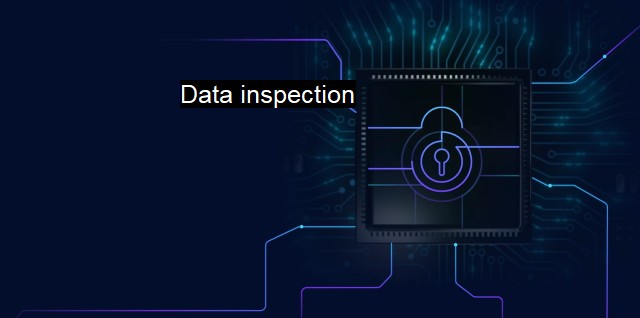What is Data inspection?
Enhancing Cybersecurity through Data Inspection: Exploring the Techniques and Tools Used to Detect and Prevent Malware Attacks
Data inspection is a critical process in cybersecurity and antivirus strategies, which primarily involves observing, analysing, and ensuring the integrity, confidentiality, and availability of data. It is a comprehensive overview of stored data to reaffirm its quality and security and to spot any inaccuracies, inconsistencies or anomalies that may exist within the information. it forms part of an organization's routine security strategy, contributing to general security hygiene.Within the realms of cybersecurity, data inspection is employed as a risk mitigation strategy. The organizations' data are a treasure trove of valuable insights into the operations, performance, and customer behaviours. mismanagement or non-inspection of this stored information can present massive security risks as they provide a lucrative target for cyber threats and attackers who are constantly seeking security vulnerabilities.
But how exactly does data inspection contribute to an organization’s security? The truth is, security is not a one-size-fits-all solution, different organizations, use-cases, and sectors will invoke varying security procedures. Data inspection provides insights into the context of data, involving identity classification, location identifiers, and content analysis. By validating data, it’s potential for fully authorized and secure usage increases, ensuring that only accurate, complete, and reliable data are utilized for decision-making purposes.
Antivirus software also uses data inspection as a means to detect, defend, and deter potential threats. Most modern antivirus programs employ different tactics to maintain secure environments. An antivirus solution usually provides real-time protection through file inspection, an integral form of data inspection. This includes scanning files as they are accessed or during an action like opening or creating them, inspecting potential threats in downloads, attachments, or system processes in real-time.
Antivirus tools and solutions typically deal with a signature-based detection model, which relies heavily on the frequent inspection of stored and dynamic data, analyzing them against a set of known malware definitions or signatures. The antivirus software will identify and extract potential patterns of data, which are then matched against their pre-existing database of threats for detection and neutralisation.
In addition to signature-based detection, antivirus software nowadays also employ what is termed heuristic-based detection, which utilizes sophisticated algorithms to examine the behaviour or attributes of objects to identify unknown or new threats. Here, data inspection plays a pivotal role in the antivirus's capacity to not only protect against known threats but also proactively identify and mitigate novel attacks, thereby contributing to a robust cybersecurity defence.
On another level, the process of data inspection aids in identifying change patterns over time, which alerts cybersecurity teams about unusual behaviours or unexpected data outliers, often implying potential security concerns in the system. Through the periodic inspection of the data, potential attacks and threat patterns can successfully be forecasted even before they materialize into a full-on cybersecurity incident.
Integrating data inspection into cybersecurity strategy also avails penetration testing and vulnerability assessments, reducing risk exposure. By having a clear snapshot of the full scope of their data, organizations can subject their systems to stringent data compliance and governance to abide by regulatory guidelines.
Data inspection is a foundational aspect of a robust cybersecurity and antivirus approach. It is a rigorous process that enables mirroring the vast and diverse threat landscape. As the data drive most of today’s digital world, ensuring data security takes higher precedence. English cybersecurity and antivirus measures would be incomplete without continuous, efficient, and intelligent data inspection procedures— the primary defence against an array of evolving and sophisticated cyber attacks.

Data inspection FAQs
What is data inspection in cybersecurity?
Data inspection is a process of analyzing and examining data to identify and prevent malicious activities that can compromise the security of a system or network. It involves scrutinizing data traffic, files, and other network activities to identify threats and vulnerabilities.Why is data inspection important in cybersecurity?
Data inspection is essential in cybersecurity as it helps detect and prevent cyber attacks. It allows organizations to identify and evaluate threats before they can cause any damage. Data inspection helps organizations to stay ahead of cybercriminals, and safeguard their network and data from loss, theft, or damage.What techniques are used for data inspection in antivirus software?
Antivirus software uses various techniques for data inspection such as signature-based detection, behavior-based detection, and heuristics analysis. Signature-based detection involves comparing data traffic to a database of known threats. Behavior-based detection detects suspicious activities based on behavior patterns of malicious code. Heuristics analysis examines the behavior of a program to determine if it is suspicious or not.Can data inspection prevent all cyberattacks?
No, data inspection cannot prevent all cyber attacks, but it can significantly reduce the risk of a security breach. Cybercriminals are continually developing new methods to bypass security measures, but data inspection can help identify and prevent most of these attacks. Therefore, It is important to use data inspection in conjunction with other security measures to ensure complete protection.| | A | | | B | | | C | | | D | | | E | | | F | | | G | | | H | | | I | | | J | | | K | | | L | | | M | |
| | N | | | O | | | P | | | Q | | | R | | | S | | | T | | | U | | | V | | | W | | | X | | | Y | | | Z | |
| | 1 | | | 2 | | | 3 | | | 4 | | | 7 | | | 8 | | |||||||